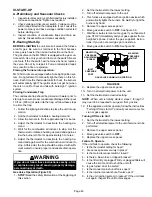
Page 49
FIGURE 63
TEMPERATURE RISE
Supply Duct Temperature ________
Return Duct Temperature
_
_____
Temperature Rise = ________
SUPPLY
AIR
Temperature
s
RETURN AIR
C-External Static Pressure
1 - Tap locations shown in figure .
2 - Punch a 1/4” diameter hole in supply and return air ple
nums. See figure 64. Insert manometer hose flush with
inside edge of hole or insulation. Seal around the hose
with permagum. Connect the zero end of the manome
ter to the discharge (supply) side of the system. On
ducted systems, connect the other end of manometer
to the return duct as above.
3 - With only the blower motor running and the evaporator
coil dry, observe the manometer reading. Adjust blow
er motor speed to deliver the air desired according to
the job requirements. For heating speed external static
pressure drop must not be more than 0.5” W.C. For
cooling speed external static pressure drop must not
be more than 0.8” W.C.
4 - Seal the hole when the check is complete.
EXTERNAL STATIC PRESSURE
Supply Duct Static ________
Return Duct _____
Total Duct Static =
________
(dry coil)
Duct Static
or
Supply Air
Return Air
FIGURE 64
D-Blower Speed Taps
Blower speed tap changes are made on the integrated con
trol. See figure 4. The heating tap is connected to the
“HEAT” terminal and the cooling tap is connected to the
“COOL” terminal. On all units the continuous blower tap is
connected to the “FAN” terminal. Unused taps must be se
cured on two dummy terminals labeled ”PARK. To change
out existing speed tap, turn off power and switch out speed
tap with tap connected to “PARK”. See blower speed tap
table on unit diagram for motor tap colors for each speed.
VI-MAINTENANCE
WARNING
ELECTRICAL SHOCK, FIRE,
OR EXPLOSION HAZARD.
Failure to follow safety warnings exactly could result
in dangerous operation, serious injury, death or
property damage.
Improper servicing could result in dangerous opera
tion, serious injury, death, or property damage.
Before servicing, disconnect all electrical power to
furnace.
When servicing controls, label all wires prior to dis
connecting. Take care to reconnect wires correctly.
Verify proper operation after servicing.
At the beginning of each heating season, system should be
checked as follows by a qualified service technician:












































